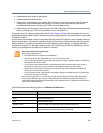
System Management and Maintenance
Polycom, Inc. 392
See also:
Management and Maintenance Overview
Recommended Regular Maintenance
Basic Upgrade Procedures
Incompatible Software Version Supercluster Upgrades
Factors to Consider for an Incremental Supercluster Upgrade
Simplified Supercluster Upgrade (Complete Service Outage)
Complex Supercluster Upgrade (Some Service Maintained)
Basic Upgrade Procedures
Caution: Upgrade considerations
Always check the upgrade version release notes before installing an upgrade.
The upgrade installation process automatically creates a backup, which enables you to roll back an
upgrade (restore the previous version) if necessary. As a precaution, however, we recommend that
you download a recent backup file or take a snapshot of your VM instance (for Virtual Edition systems)
before you begin to install an upgrade. See Backing Up and Restoring.
You can roll back only the last applied upgrade. Rolling back an upgrade restores the database to its
state prior to the upgrade, so data may be lost.
The procedure below is for:
• Installing any software upgrade on a single-server or two-server system that’s not part of a
supercluster.
• Installing a patch (supercluster-compatible software upgrade) on a cluster that’s part of a
supercluster. In that case, you repeat the procedure on each cluster.
To apply a major or minor software upgrade (not supercluster-compatible) to a superclustered system,
see Incompatible Software Version Supercluster Upgrades.
Note: Upgrade tips
To minimize the time required for an upgrade:
• If the upgrade requires a new license, obtain the license activation key(s) ahead of time.
• If upgrading an Appliance Edition system, download a recent backup and upload the upgrade
package file (the first five steps below) ahead of time. For a supercluster, do this on each cluster.
• Perform the remainder of the procedure during a maintenance window when there are no calls or
conferences so that you can immediately take the cluster out of service instead of having to wait for
all activity to end.
Using a maintenance window with no calls on the system also eliminates any concerns about whether
the remaining clusters of a supercluster have sufficient capacity to handle the load of the cluster being
upgraded.


















